
The morning coffee ritual has transcended mere caffeine consumption to become a sacred psychological anchoring practice in our homes. A dedicated coffee station nook transforms this daily routine into an intentional experience, carving out a micro-sanctuary that signals to our brains: this is where restoration begins.
In order to come up with the very specific design ideas, we create most designs with the assistance of state-of-the-art AI interior design software.
These thoughtfully designed spaces tap into our deep-seated need for order and personalization, creating what I call “ritual architecture”—physical environments that elevate mundane tasks into meaningful moments. Whether you’re working with a sprawling kitchen or a compact corner, these 25 coffee station ideas prove that luxury isn’t about square footage; it’s about intentionality, design cohesion, and understanding how our spaces shape our daily emotional landscape.
Minimalist Corner Coffee Station Nook Design
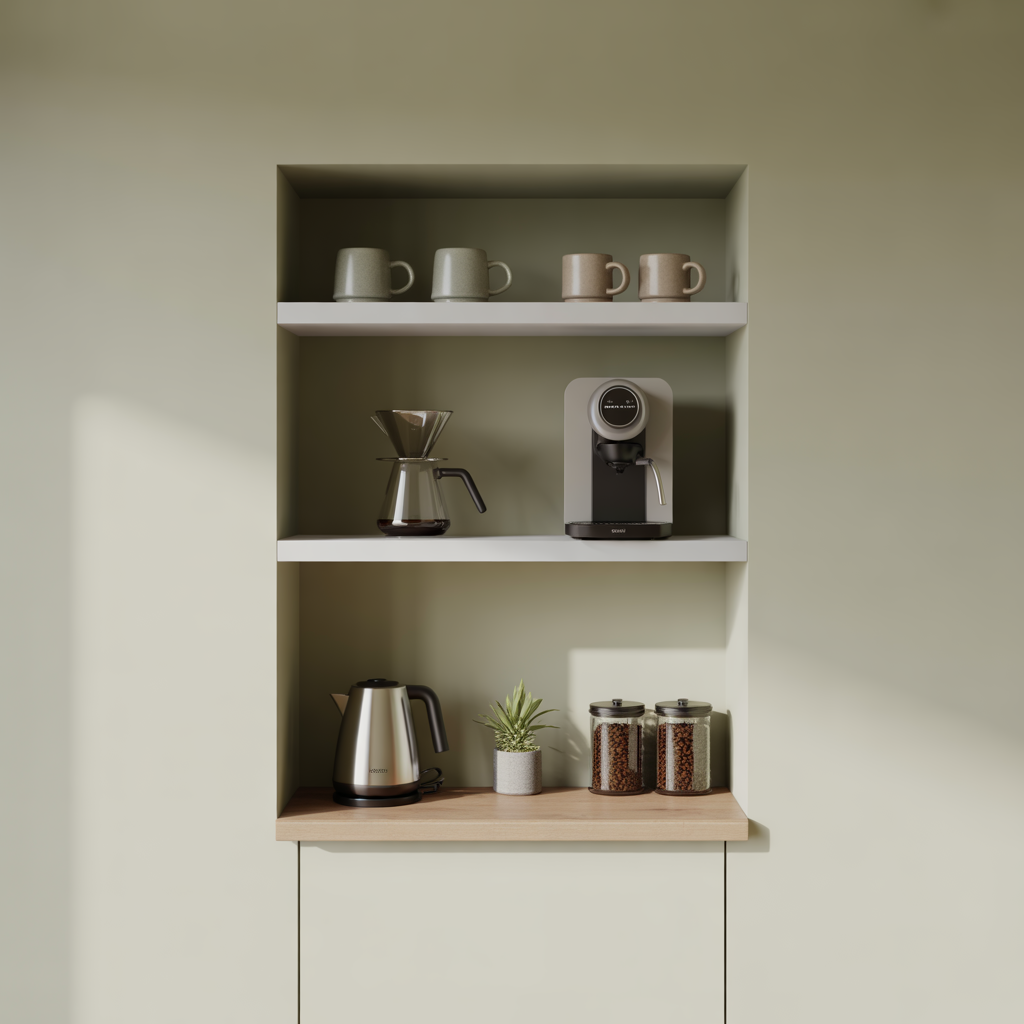
The minimalist corner coffee station embodies the psychological principle that less visual clutter equals mental clarity. This design features clean lines, a monochromatic palette, and only essential items displayed with purposeful negative space. A simple white countertop with a high-quality espresso machine, a single glass canister for beans, and perhaps one cherished mug creates what I term “meditative functionality.”
The beauty lies in restraint—each element earns its place through both utility and aesthetic contribution. This approach works particularly well for those who find visual chaos mentally draining, transforming the morning coffee routine into a calming, almost zen-like experience that sets a peaceful tone.
Rustic Farmhouse Coffee Station Nook Setup
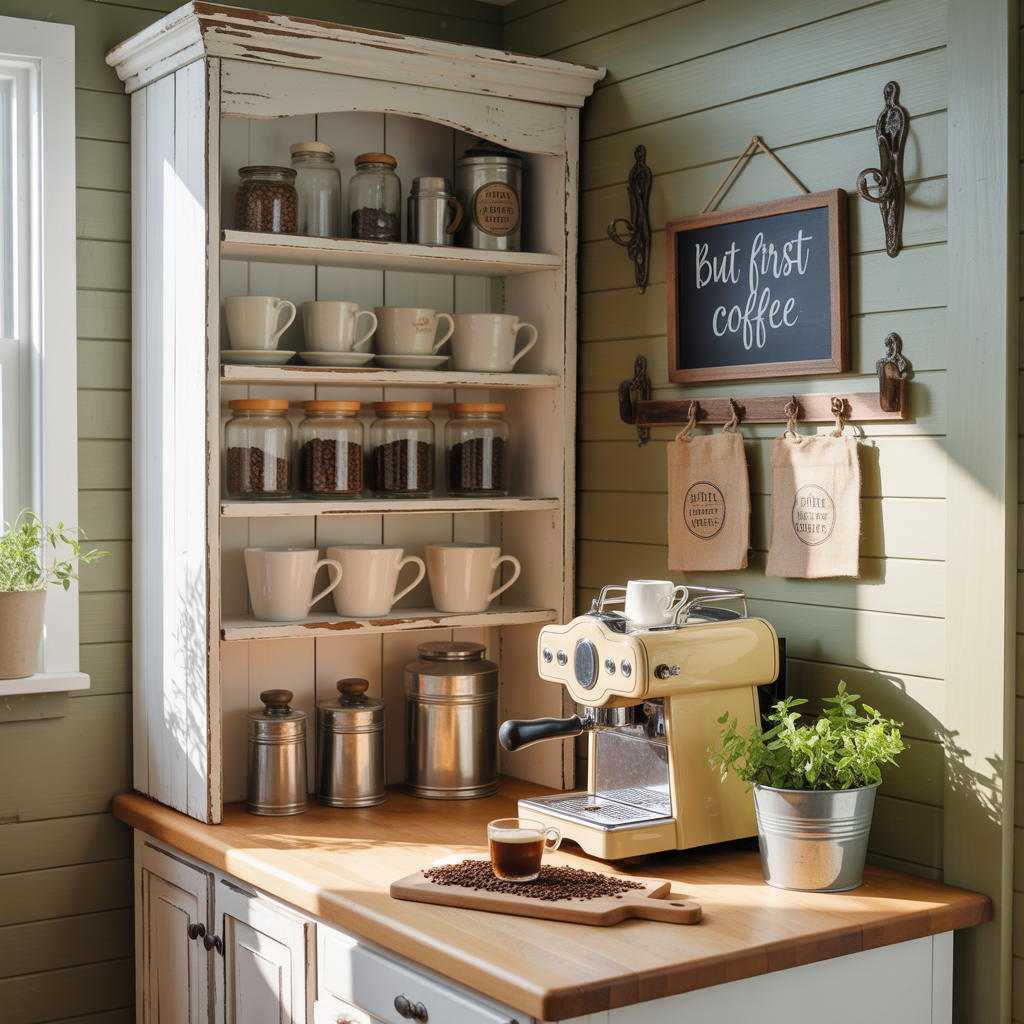
Rustic farmhouse coffee stations evoke nostalgic comfort through weathered wood, vintage accessories, and that coveted “lived-in” aesthetic that psychologically signals safety and warmth. Reclaimed barn wood shelving, galvanized metal containers, and mason jar storage create layers of textural interest that engage our tactile sensibilities.
This design style taps into our collective yearning for simpler times and authentic craftsmanship, what I call “heritage anchoring”—using design elements that connect us to imagined or real pastoral traditions. The intentional imperfections in distressed finishes actually reduce performance anxiety around keeping spaces pristine, making this ideal for busy households seeking approachable elegance.
Coffee Station Nook with Built-In Shelving

Built-in shelving transforms a coffee station from afterthought to architectural feature, creating the psychological impact of permanence and intentional design. Custom cabinetry that reaches the ceiling maximizes vertical storage while establishing the coffee nook as a deliberate focal point rather than a makeshift arrangement.
This approach satisfies our innate desire for “everything in its place,” reducing decision fatigue each morning by providing designated homes for mugs, beans, sweeteners, and brewing equipment. The investment in built-ins signals to household members and guests alike that the coffee ritual holds valued status in your home’s hierarchy of activities, elevating a simple beverage preparation into honored domestic ceremony.
Compact Kitchen Counter Coffee Station Nook
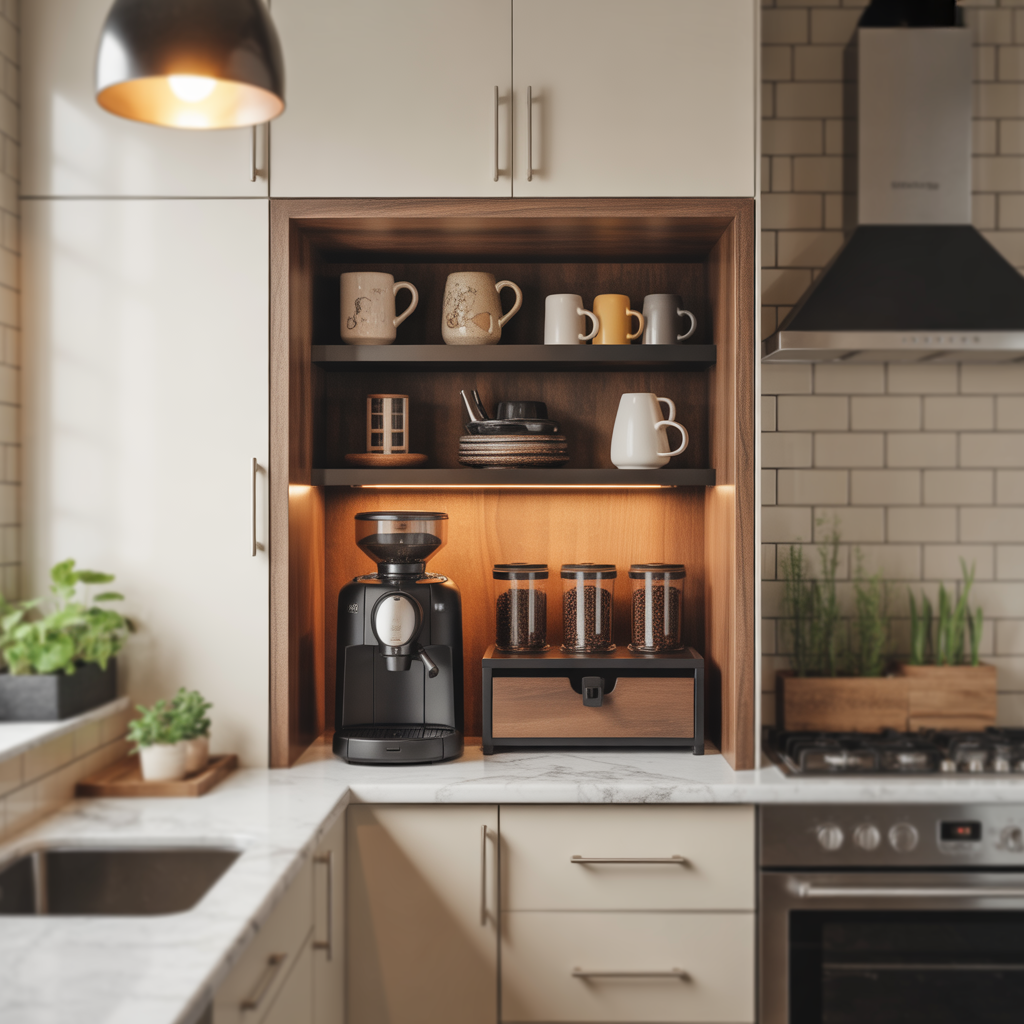
The compact counter coffee station proves that spatial constraints can actually enhance creativity and intentionality in design. By claiming just eighteen to twenty-four inches of counter space, you create a defined zone that prevents the common kitchen phenomenon of coffee supplies migrating across surfaces.
This condensed approach leverages the psychological concept of containment—our brains appreciate clearly delineated spaces for specific functions. Utilize tiered organizers, wall-mounted mug racks, and a slim-profile coffee maker to maximize functionality within minimal footprint. The compact station works particularly well in urban apartments where every square inch demands strategic purpose, demonstrating that thoughtful design transcends square footage limitations entirely.
Vintage-Inspired Coffee Station Nook Corner

Vintage coffee stations channel specific eras—whether mid-century modern, art deco, or retro diner aesthetics—to create temporal depth in contemporary homes. Sourcing an authentic vintage percolator, antique coffee grinder, or 1950s Formica table as your foundation piece establishes narrative continuity that transforms functional space into conversation starter. This design psychology works because humans are inherently story-seeking creatures; we assign greater meaning to objects and spaces with perceived histories.
The patina of age, whether authentic or artfully distressed, provides visual richness that brand-new items simply cannot replicate. Vintage elements also offer sustainable design solutions, giving pre-loved items renewed purpose while satisfying our growing environmental consciousness.
Coffee Station Nook with Under Cabinet Lighting
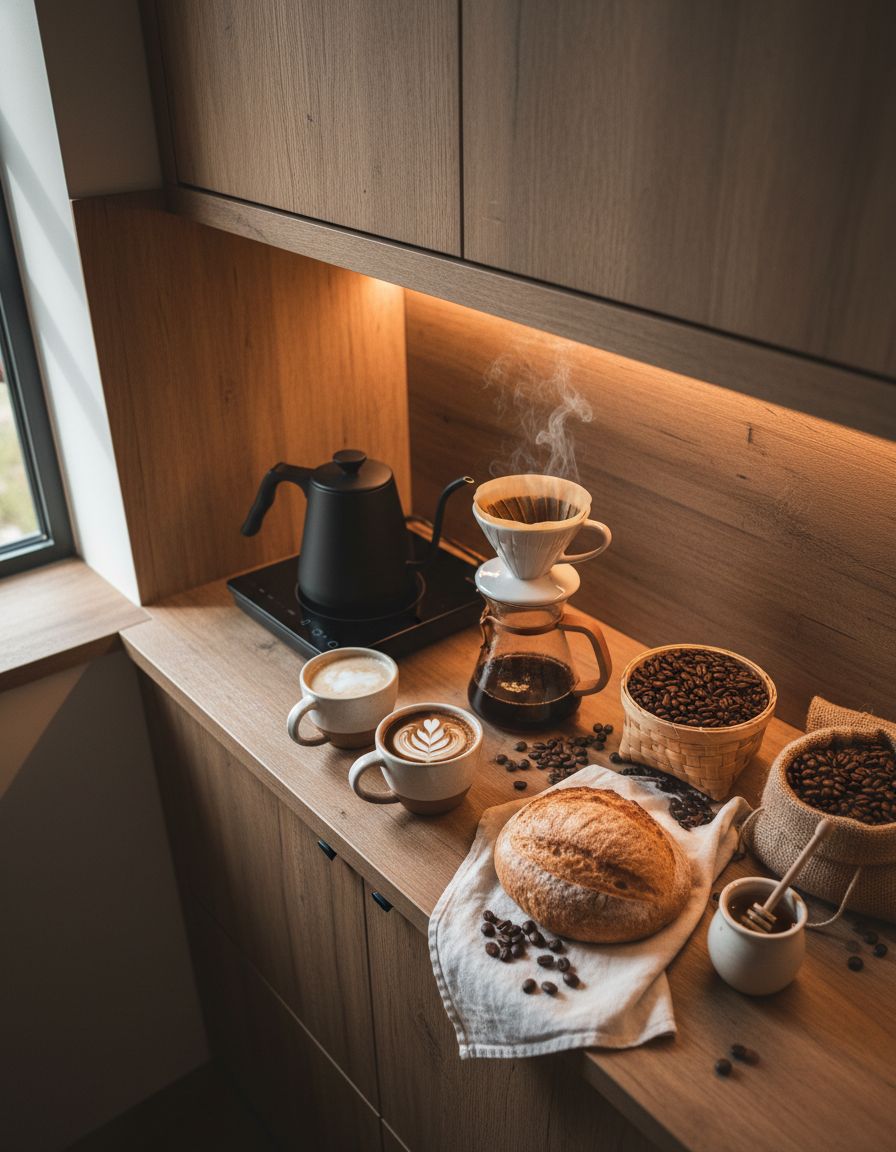
Strategic under-cabinet lighting transforms a coffee station from purely functional to genuinely atmospheric, addressing both practical and emotional needs. Warm LED strips installed beneath upper cabinets eliminate shadows on work surfaces while creating ambient glow that feels intentionally hospitality-focused rather than clinically bright.
This lighting approach taps into what I call “micro-ambiance”—small environmental adjustments that significantly impact mood and perceived comfort. The gentle illumination makes early morning coffee preparation less jarring to sleep-adjusted eyes while visually highlighting your carefully curated station elements. Dimmable options allow you to adjust brightness according to time of day or desired energy level, making light itself an interactive design element.
Coffee Station Nook with Floating Shelves
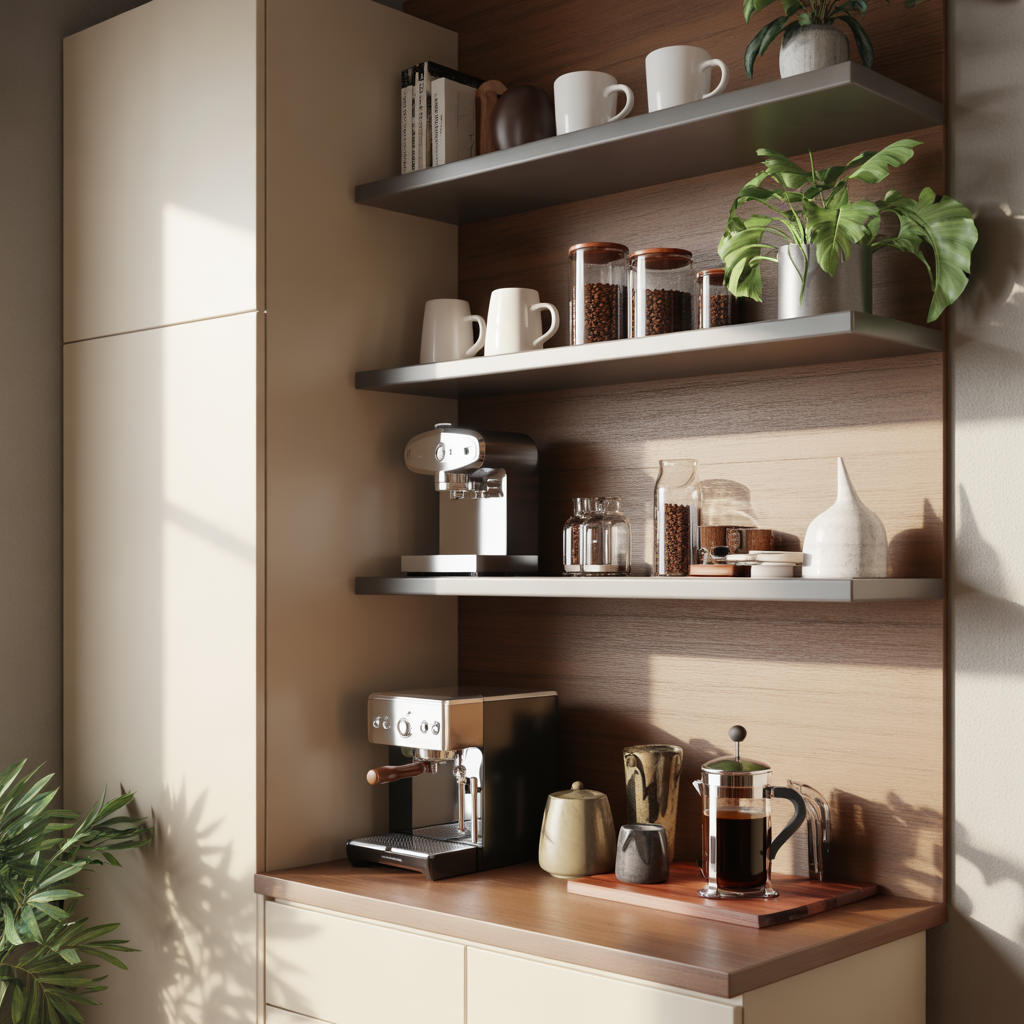
Floating shelves create visual lightness while providing essential storage, making them ideal for coffee stations where you want functional display without visual heaviness. The absence of visible brackets produces a seemingly effortless aesthetic that appeals to our attraction to graceful solutions and apparent simplicity.
This approach works brilliantly for showcasing beautiful coffee accessories—artisan mugs, glass canisters, or collected coffee table books—transforming utilitarian storage into curated display. Psychologically, open shelving creates accountability for maintaining organization, as everything remains visible rather than hidden behind closed doors. The floating configuration also draws the eye upward, making spaces feel larger and more expansive than traditional closed cabinetry allows.
Industrial Metal Coffee Station Nook Design
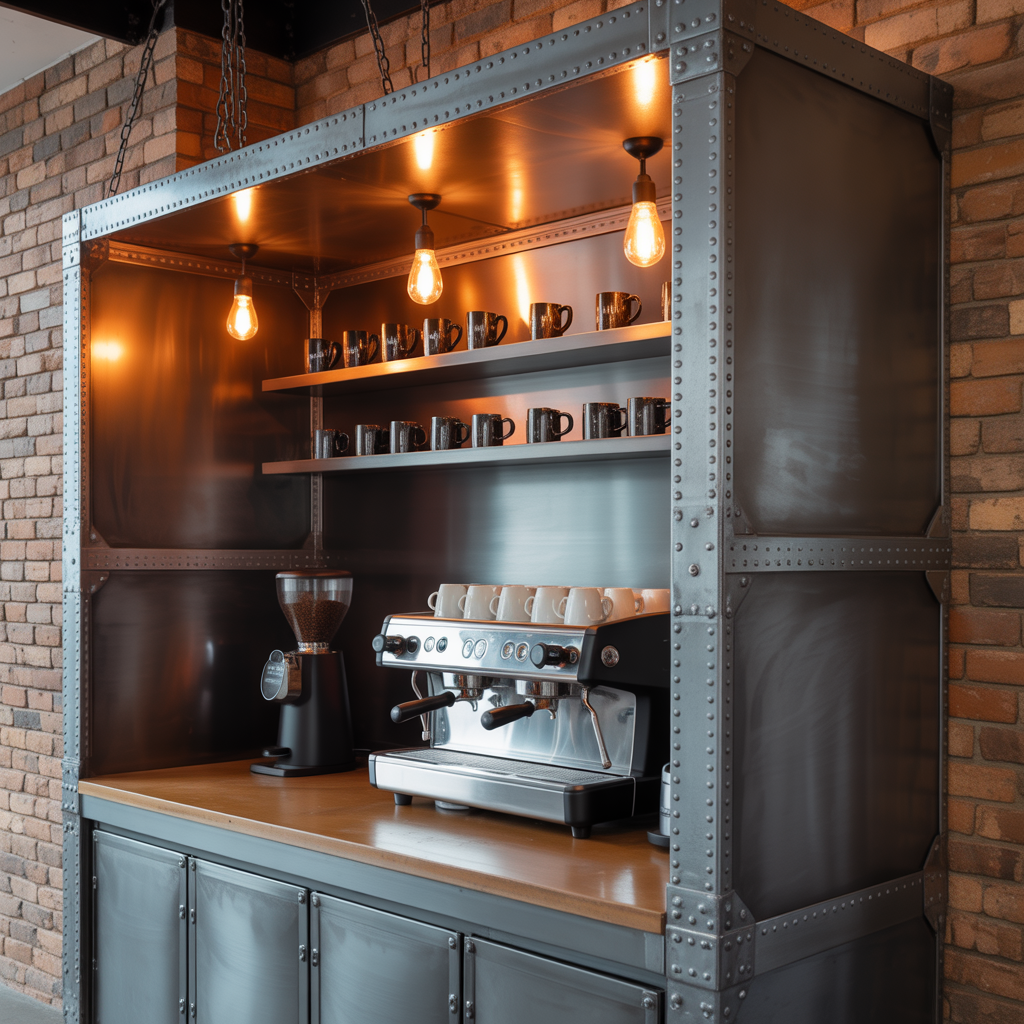
Industrial coffee stations featuring raw metal, exposed hardware, and utilitarian finishes create what I term “authentic utility aesthetic”—design that celebrates function without apologizing for it. Black iron pipe shelving, stainless steel countertops, and Edison bulb pendants establish an urban-loft sensibility that resonates with those who appreciate honest materials and straightforward construction.
This style psychologically appeals to our fascination with seeing how things work, revealing structural elements typically hidden in conventional design. The industrial approach also offers remarkable durability—metal shelving and commercial-grade surfaces withstand heavy daily use while developing character through natural patina. For coffee enthusiasts who view brewing as craft rather than convenience, industrial design provides appropriately workshop-like environment.
Coffee Station Nook with Tile Backsplash

A distinctive tile backsplash transforms the coffee station into a miniature feature wall, providing both practical splatter protection and significant visual interest. Whether you choose classic subway tiles, Moroccan zellige, or bold geometric patterns, the backsplash establishes the station as an intentional design moment rather than leftover counter space.
Psychologically, the defined boundary created by contrasting tile signals “special zone” to our pattern-recognizing brains, elevating the perceived importance of the coffee ritual occurring there. The tile also introduces texture, color, and potential for personalization that flat painted walls cannot achieve. Consider extending the backsplash several feet beyond the actual station boundaries to create generous visual presence.
Coffee Station Nook in Breakfast Bar

Integrating the coffee station into a breakfast bar creates efficient spatial synergy while establishing a natural gathering point that encourages social connection. This design acknowledges that coffee preparation often coincides with morning conversations, newspaper reading, or quiet contemplation alongside loved ones. The breakfast bar configuration provides comfortable seating at the ideal height for observing the brewing process or simply lingering over that first cup.
Psychologically, this setup reduces the isolation sometimes felt in solitary coffee-making, instead creating opportunities for companionship or peaceful parallel presence. The dual-purpose design also maximizes functionality in open-concept homes where distinct rooms give way to flowing, multi-use spaces.
Coffee Station Nook with Wine Rack
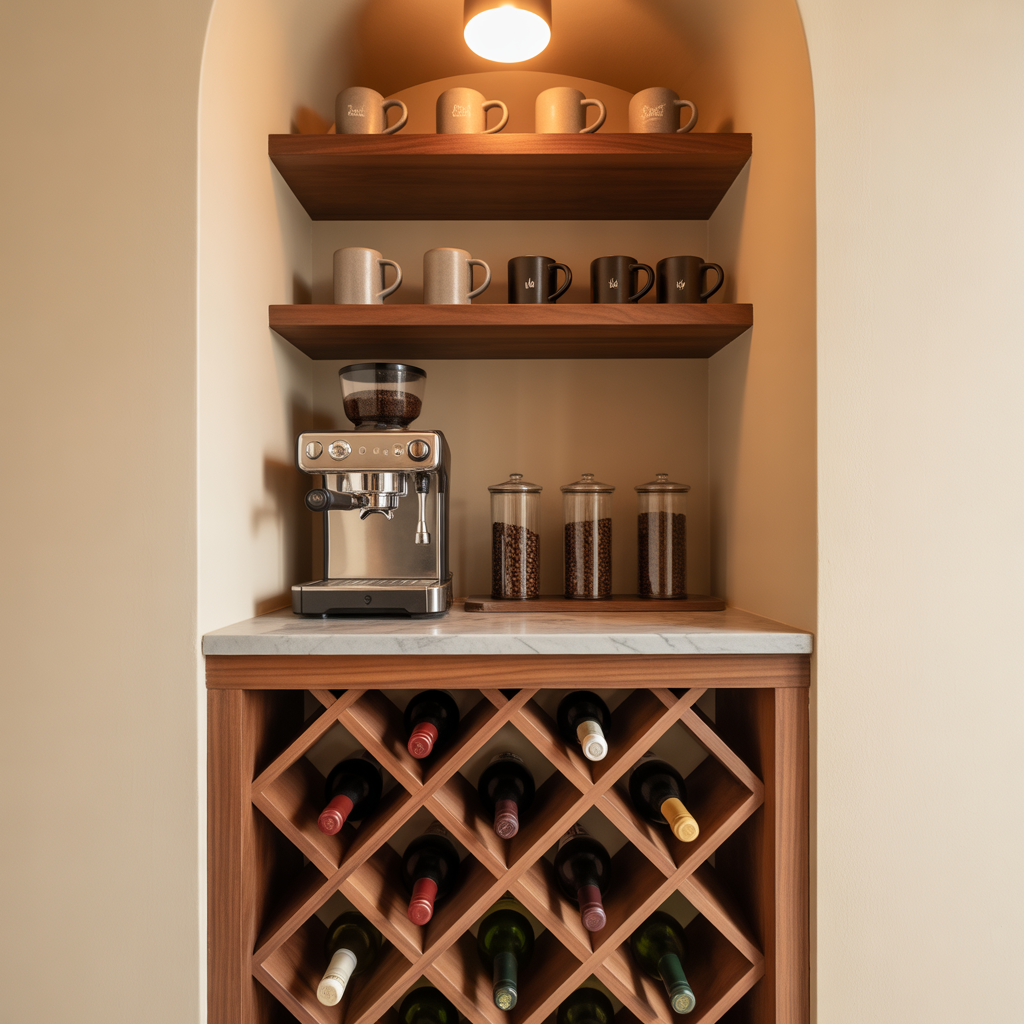
Pairing coffee storage with wine display creates what I call “beverage bookends”—acknowledging the ritualistic importance of both morning energizers and evening relaxants. This design approach recognizes that many coffee enthusiasts equally appreciate wine, sharing similar values around quality, origin stories, and preparation rituals.
A wall-mounted wine rack above or beside coffee equipment establishes visual balance while maximizing vertical storage potential. The juxtaposition creates interesting dialogue between opposing beverage purposes—one stimulating, one sedating—representing the full spectrum of domestic hospitality. This combination works particularly well in butler’s pantries, dining room corners, or entertainment areas where both beverages naturally congregate during gatherings.
Coffee Station Nook Using Bar Cart

The wheeled bar cart coffee station offers unmatched flexibility, allowing you to relocate your entire setup for entertaining, deep cleaning, or seasonal rearranging. This mobile approach appeals to renters, frequent movers, or those who resist permanent design commitments, providing coffee station functionality without architectural modification.
Psychologically, the portability reduces feelings of being “locked in” to specific layouts, satisfying our desire for adaptability in increasingly changeable lives. Quality bar carts feature multiple tiers for vertical organization, keeping footprint minimal while storage capacity remains generous. The cart also enables outdoor coffee service—imagine wheeling your complete station onto a patio for weekend brunch, extending your coffee ritual beyond traditional boundaries.
Coffee Station Nook with Chalkboard Wall
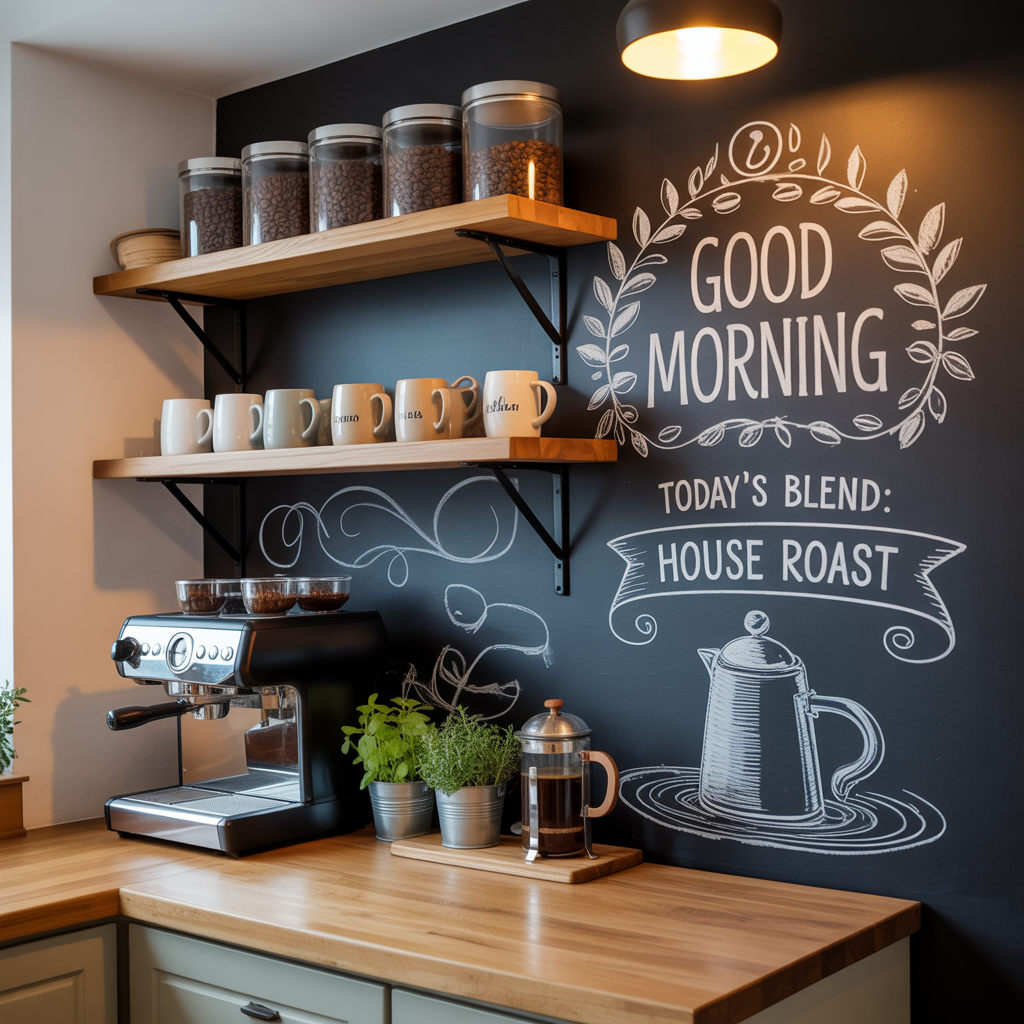
A chalkboard wall behind your coffee station introduces playful interactivity and ever-changing personalization that static design cannot provide. Write daily coffee quotes, track bean varieties, sketch latte art inspiration, or simply doodle while waiting for brew cycles to complete. This writable surface taps into our fundamental need for creative expression and marks territory as unmistakably personal space.
The matte black chalkboard finish also provides dramatic contrast that makes lighter coffee equipment and accessories visually pop. Psychologically, the permission to write directly on walls feels delightfully transgressive, recalling childhood freedoms while serving adult organizational needs. The constantly evolving content ensures your coffee nook never feels stagnant or overly precious.
Coffee Station Nook in Butler’s Pantry
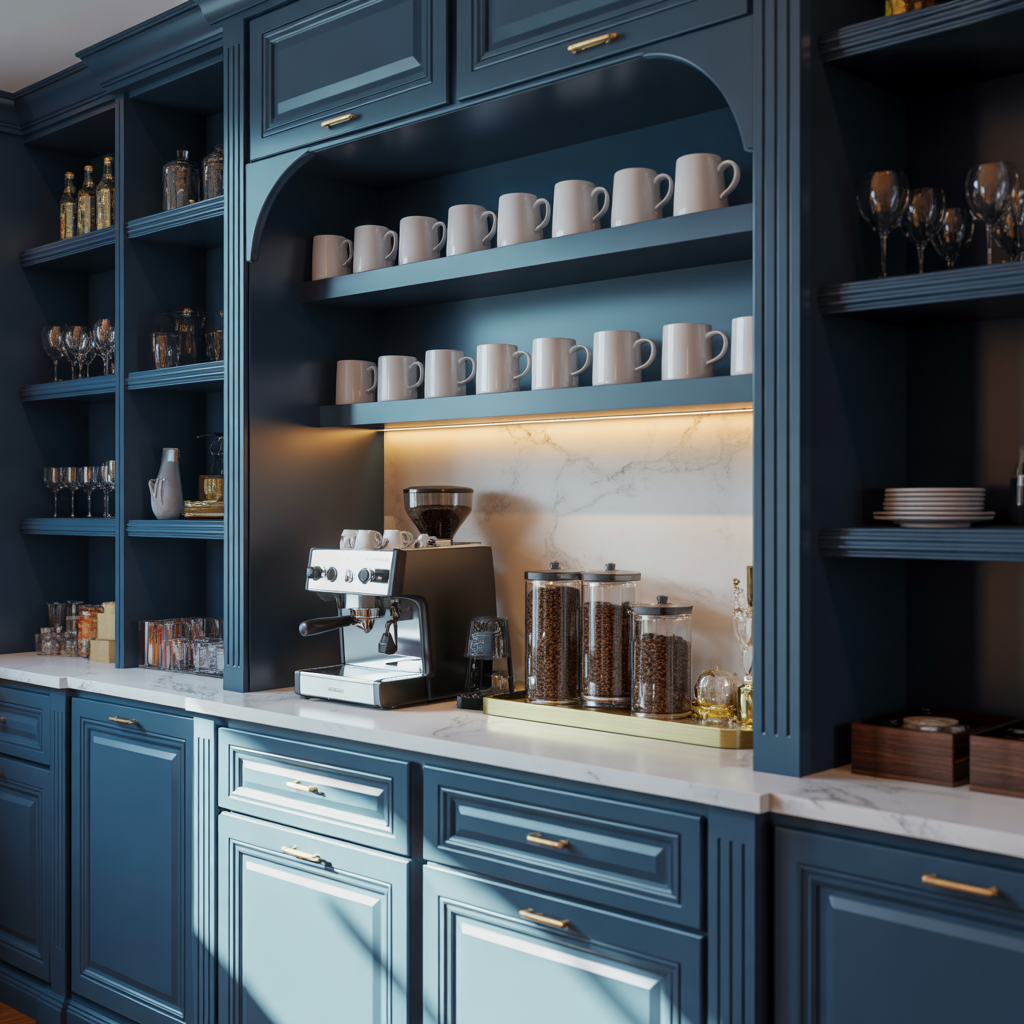
The butler’s pantry coffee station represents ultimate luxury—a dedicated room for beverage preparation that removes equipment and activity from the main kitchen entirely. This separation creates what hospitality designers call “layered entertaining,” allowing hosts to prepare drinks away from cooking chaos while maintaining guest interaction. Psychologically, the butler’s pantry station satisfies our desire for specialized spaces that elevate everyday activities to ceremonial status.
The privacy also enables you to embrace more elaborate equipment or less tidy storage solutions without concern for constant visibility. For serious coffee enthusiasts, claiming an entire pantry for coffee, tea, and bar supplies represents the pinnacle of domestic beverage dedication, creating a personal café within residential architecture.
Coffee Station Nook with Mug Display

Showcasing your mug collection transforms utilitarian storage into personal gallery, celebrating the vessels that literally hold your daily ritual. Open mug displays on hooks, rails, or shelving invite selection as part of the coffee experience—choosing today’s mug becomes an intentional decision rather than grabbing whatever’s closest. This approach honors the psychological truth that we form attachments to specific mugs, each carrying memories, gift-giver associations, or simply perfect ergonomic fit.
The visual abundance of displayed mugs also signals hospitality readiness, subtly communicating that guests are always welcome to join for coffee. Consider arranging mugs by color gradient, size, or sentiment to create cohesive visual impact beyond random collection.
Coffee Station Nook with Marble Countertop
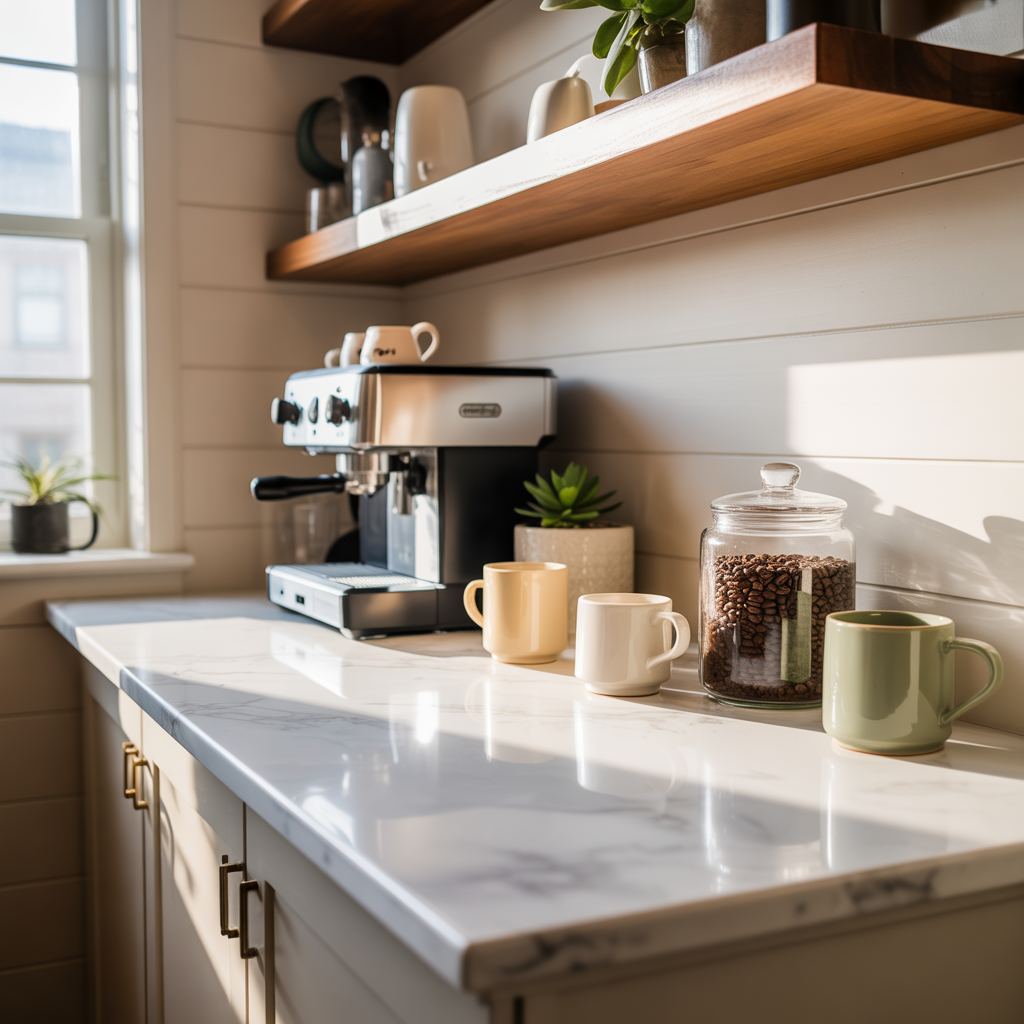
Marble countertops introduce timeless elegance and cool, smooth surfaces ideal for coffee preparation while signaling elevated design investment. The natural veining provides organic visual interest that prevents the station from feeling too sterile or predictable, with each slab offering unique patterns that ensure your space remains singular. Psychologically, marble carries associations with luxury, permanence, and classical beauty that elevate the perceived importance of activities occurring upon it.
The stone’s thermal properties keep surfaces cool, beneficial when handling hot coffee equipment or setting down freshly brewed carafes. While requiring more maintenance than engineered alternatives, marble rewards attentive care with developing patina that tells your home’s story through gentle etching and staining.
Coffee Station Nook in Kitchen Island

Dedicating kitchen island real estate to coffee creates central-location convenience while maintaining the island’s role as household gathering nucleus. This placement acknowledges that islands function as social anchors where family members naturally congregate throughout the day. Integrated coffee stations can include built-in espresso machines, dedicated electrical outlets, pull-out appliance shelves, and even small beverage refrigerators for cream storage.
The central positioning reduces steps during rushed mornings while keeping the coffee maker accessible from multiple kitchen entry points. Psychologically, island placement prevents the coffee station from feeling relegated to leftover corner space, instead positioning it as a first-tier kitchen function worthy of premium location.
Coffee Station Nook with Open Shelving
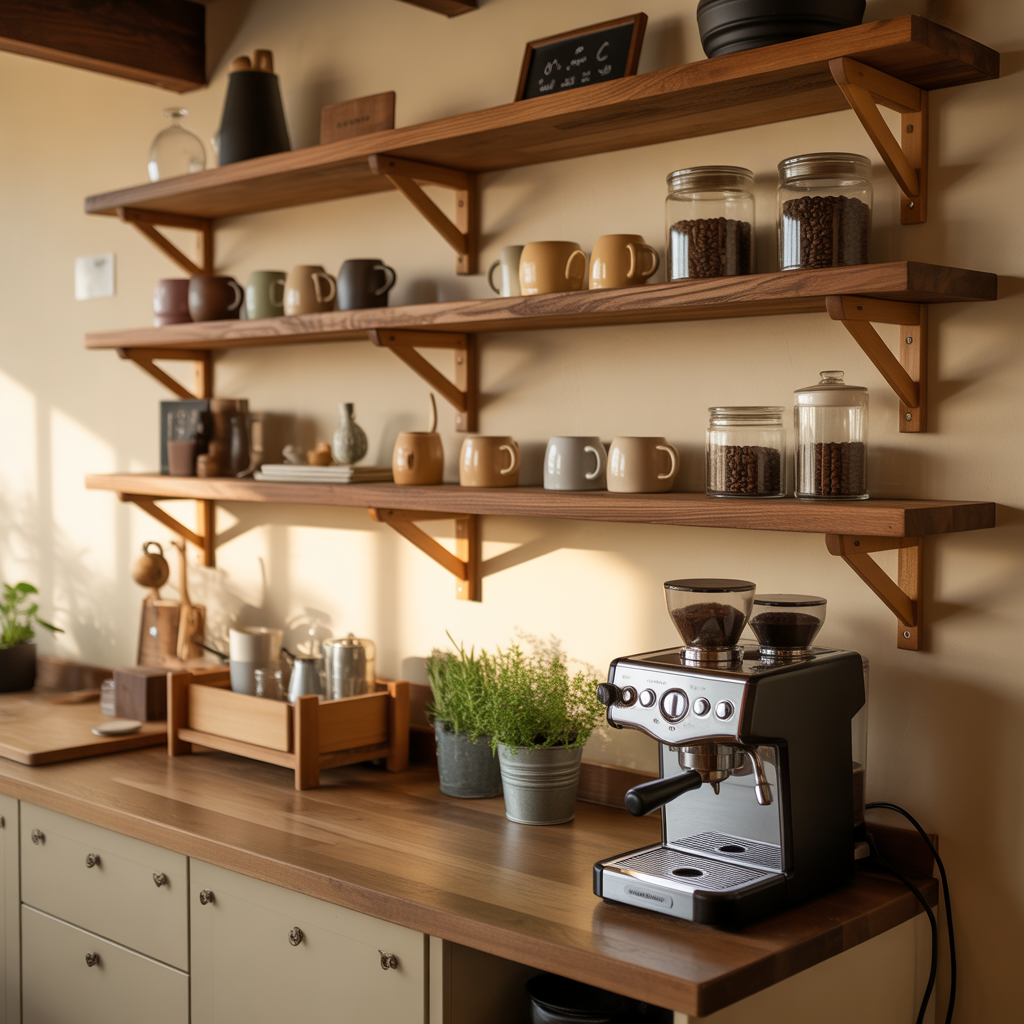
Open shelving creates transparency and accessibility that closed cabinets cannot match, turning everyday coffee supplies into styled vignettes that contribute to overall kitchen aesthetic. This approach works best for naturally organized individuals who enjoy the accountability of visible storage, as everything remains constantly on display.
The openness also speeds morning routines—no cabinet doors to navigate when you’re barely conscious and desperately seeking caffeine. Psychologically, open shelving satisfies our pattern-seeking brains by creating opportunities for symmetrical arrangement, color coordination, and collection display. The key lies in editing ruthlessly, keeping only items that serve function or beauty, preferably both simultaneously. Consider backing shelves with contrasting paint colors or wallpaper for additional visual dimension.
Coffee Station Nook Under Staircase Design
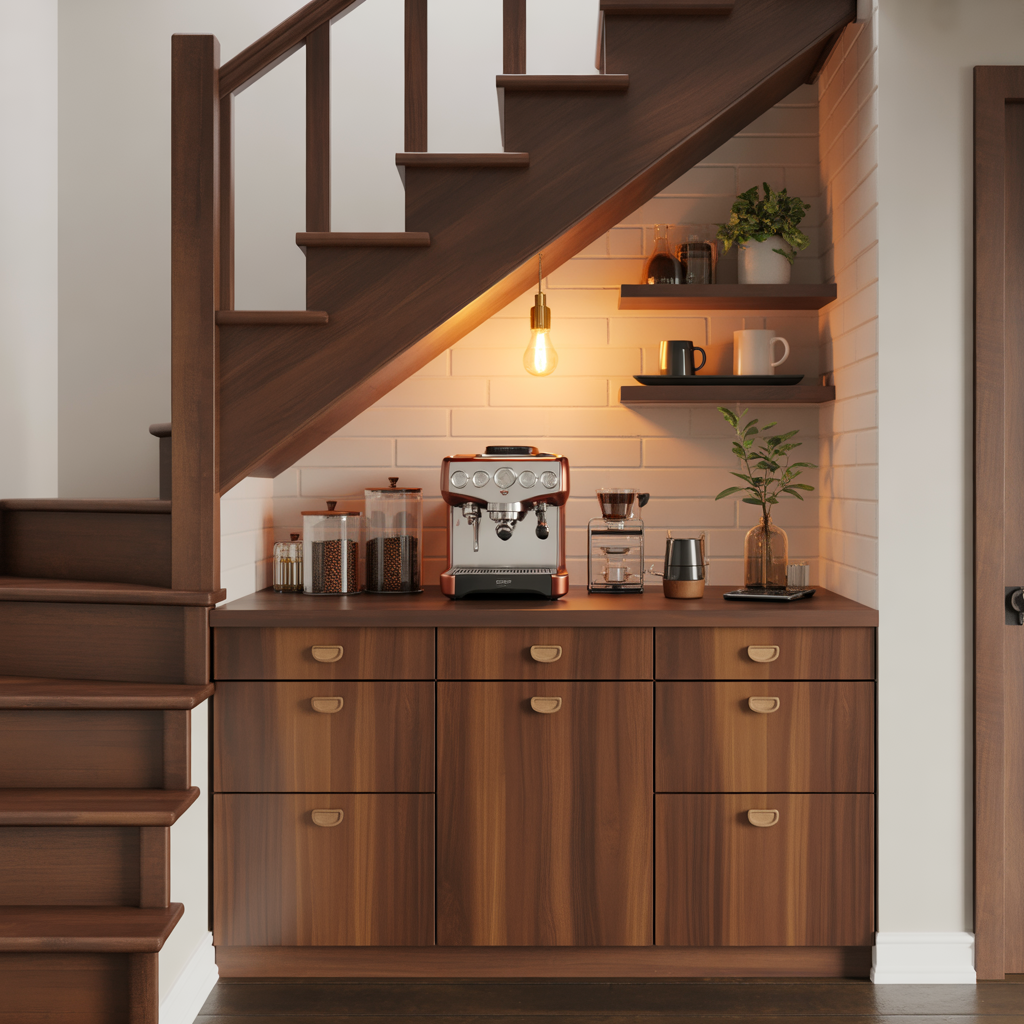
The under-staircase coffee nook brilliantly reclaims otherwise awkward, underutilized space, creating a tucked-away retreat that feels intentionally cozy rather than leftover. This placement taps into our psychological attraction to nooks, alcoves, and sheltered spaces that offer enclosure without claustrophobia—what environmental psychologists call “prospect and refuge.”
The angled ceiling created by staircase underside adds architectural interest while the partial enclosure provides welcome separation from main living areas. This location works particularly well for those who view coffee preparation as a meditative solo activity rather than social event. Custom cabinetry that follows the staircase slope maximizes every inch of available height while creating a built-in appearance.
Coffee Station Nook with Glass Canisters
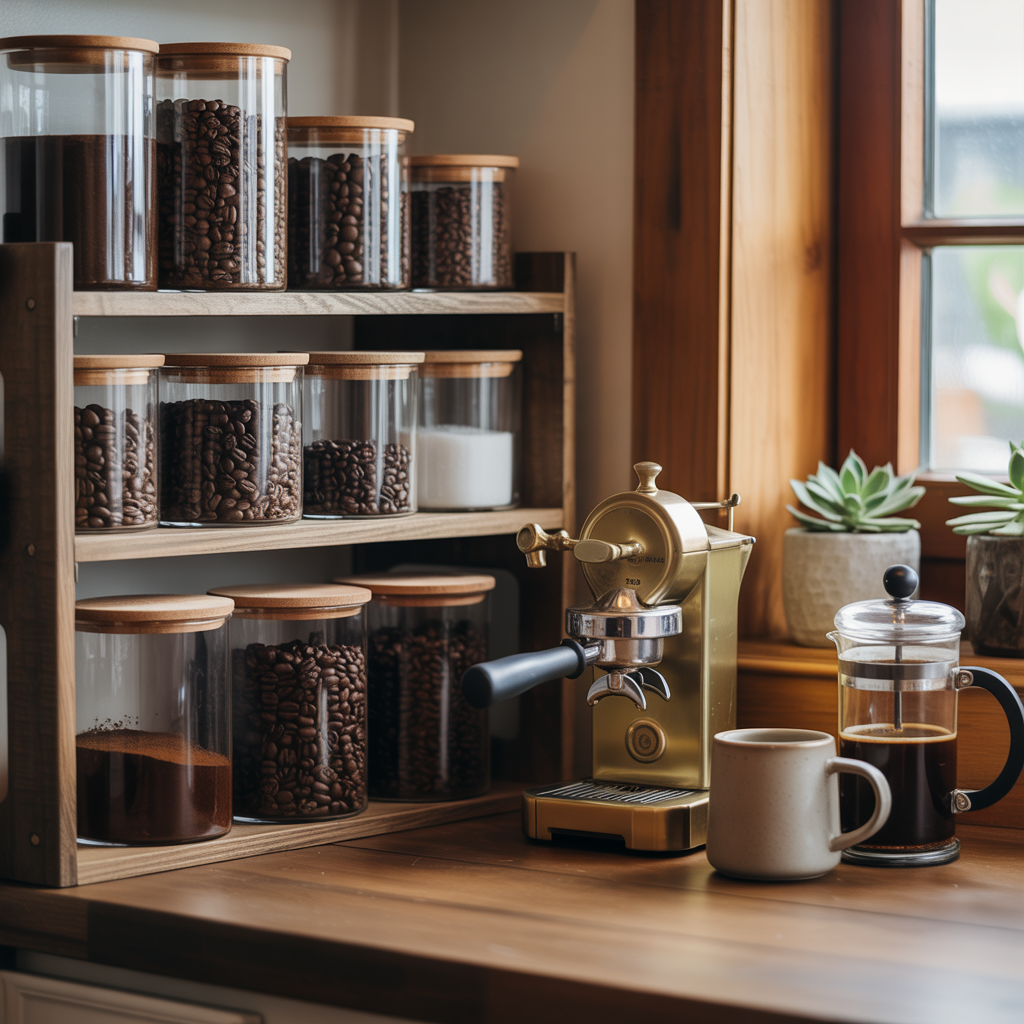
Clear glass canisters transform coffee beans, sugar, and supplies into visual elements, adding color, texture, and organic shapes to your station’s aesthetic composition. This transparency allows you to monitor supply levels at a glance while the varied contents create natural visual interest through their different colors and sizes.
Psychologically, seeing whole coffee beans signals freshness and quality in ways that hidden storage cannot communicate. The glass also protects contents from moisture and pests while permitting light interaction that makes the entire station feel more alive and dynamic. Choose uniform canister styles for cohesive appearance, or embrace eclectic vintage glass containers for more collected, personalized character.
Coffee Station Nook in Dining Room
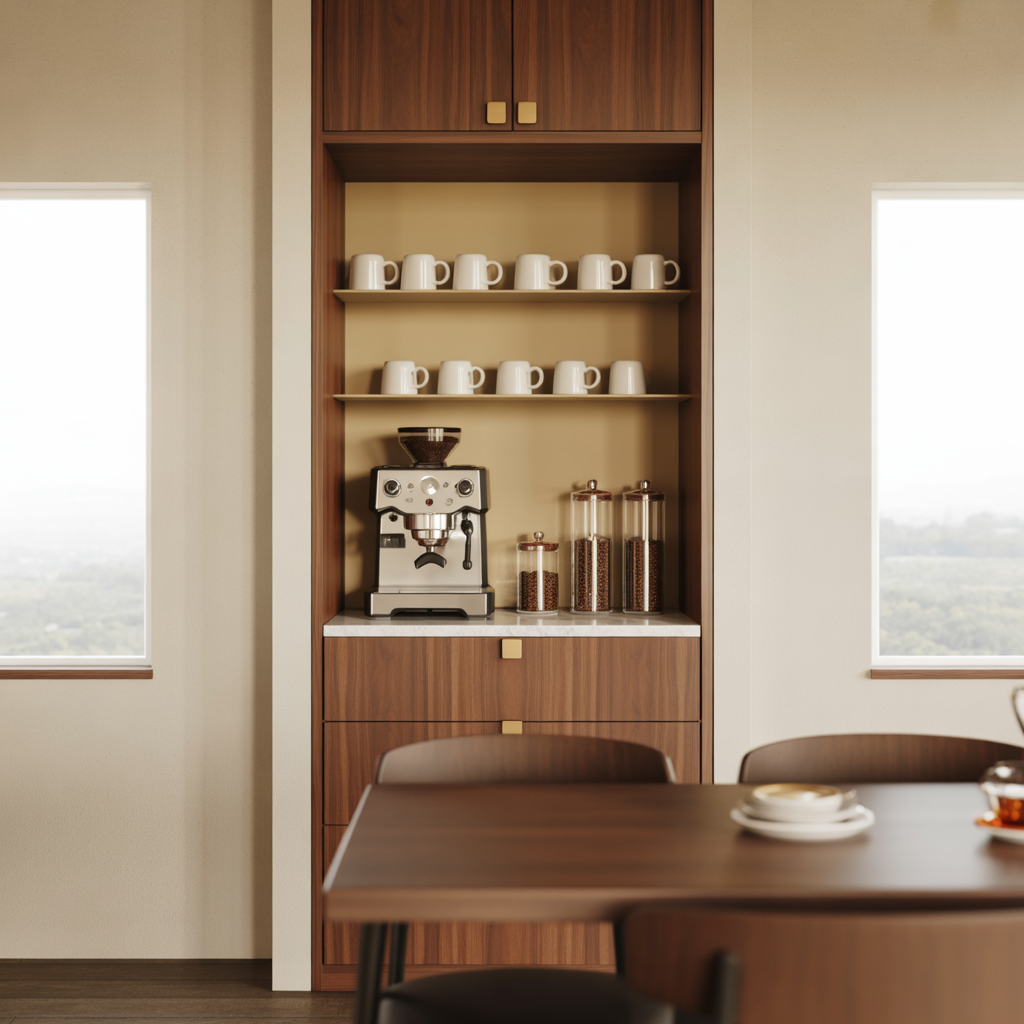
Positioning a coffee station in the dining room creates elegant transition space between meal courses and acknowledges coffee’s traditional role concluding dinner service. This placement particularly suits homes with butler’s pantries or formal dining areas used for entertaining, where coffee service becomes part of hospitality choreography.
The dining room location also relieves kitchen congestion during gatherings, providing a secondary beverage preparation zone when the main kitchen reaches capacity. Psychologically, this configuration elevates coffee from quick kitchen grab to more ceremonial dining room ritual, encouraging lingering and conversation rather than rushed consumption. Consider pairing with a small dessert display area for complete after-dinner service capabilities.
Coffee Station Nook with Wood Accents
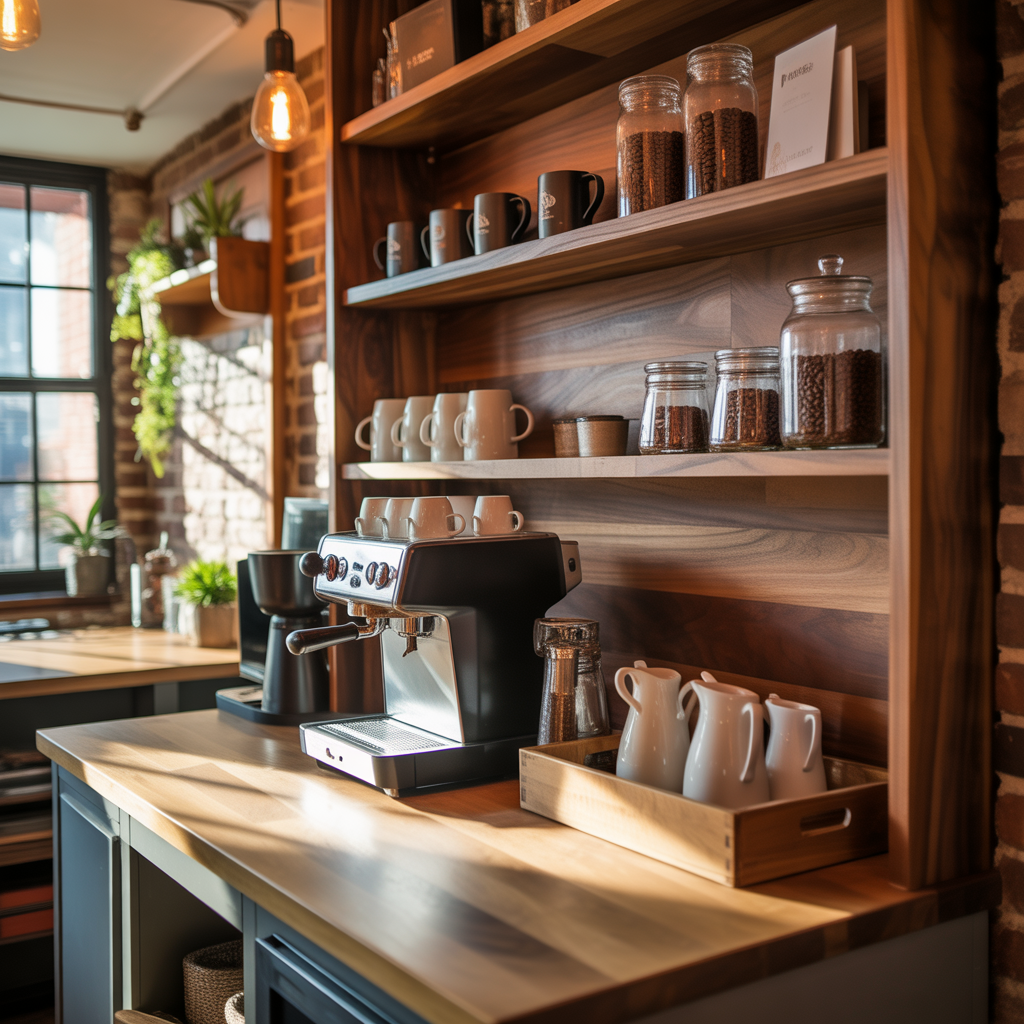
Wood accents introduce organic warmth that balances the mechanical, modern appearance of coffee equipment, creating what I call “tech-natural fusion.” Whether through butcher block countertops, reclaimed wood shelving, or simply wooden accessories like spoon holders and trays, these natural elements soften spaces while adding tactile richness.
The wood grain provides visual complexity that plain surfaces lack, ensuring the station feels intentionally designed rather than merely functional. Psychologically, natural materials reduce stress and create subconscious connections to nature even within fully interior environments. The wood also ages beautifully, developing character through coffee ring stains and gentle wear that tells your household’s story through accumulated patina.
Coffee Station Nook with Appliance Garage
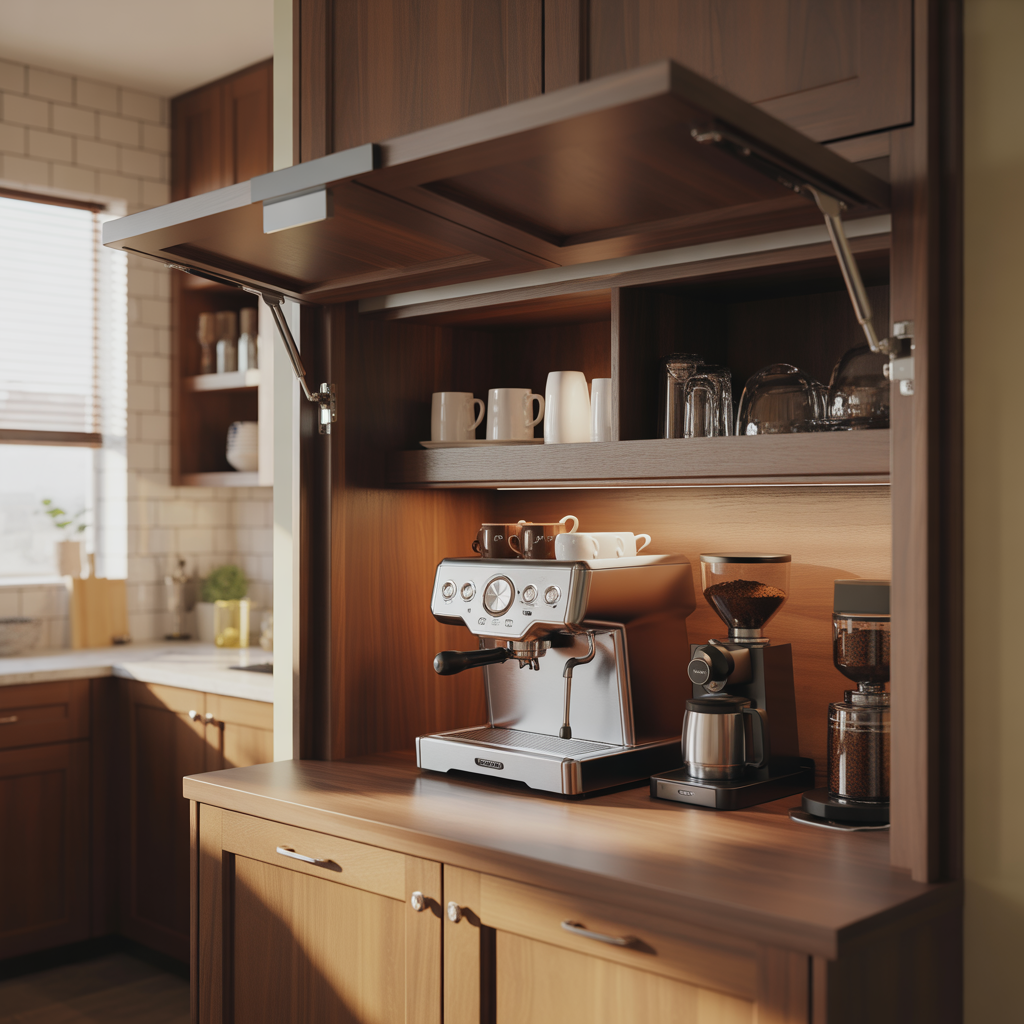
The appliance garage conceals coffee makers and grinders behind retractable doors, maintaining clean counter surfaces when equipment isn’t actively in use. This design solution appeals to those who want coffee station functionality without permanent visual clutter, satisfying the psychological need for order and control over our environments.
The garage doors simply roll up or swing open during morning routines, then close to restore seamless cabinetry appearance afterward. This approach works particularly well in kitchens where counter space is limited or aesthetic preferences lean toward minimalism. The concealment also protects expensive equipment from cooking splatter, dust accumulation, and accidental damage while maintaining instant accessibility when caffeination calls.
Coffee Station Nook with Personalized Signs

Custom signs, whether vintage-style metal, hand-lettered wood, or modern acrylic, inject personality and humor while clearly establishing the space’s dedicated purpose. Phrases like “But First, Coffee,” family name coffee company logos, or inside jokes transform generic stations into deeply personal spaces that reflect household values and communication styles. This personalization taps into our fundamental need for self-expression and territorial marking—making spaces unmistakably “ours” through customized details.
The signs also serve practical wayfinding purposes during gatherings, directing guests to coffee supplies without verbal explanation. Consider rotating seasonal signs or creating a gallery wall of coffee-related quotes, vintage advertisements, and meaningful typography that evolves as your tastes develop and your coffee journey continues.






